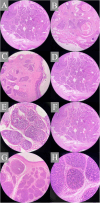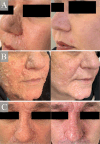Successful and Sustained Treatment of Cutaneous Tumoral Lesions in Brooke-Spiegler Syndrome (BSS) Using Ablative CO2 Laser: A Case Series and Literature Review
- PMID: 40342561
- PMCID: PMC12061494
- DOI: 10.1002/ccr3.70501
Successful and Sustained Treatment of Cutaneous Tumoral Lesions in Brooke-Spiegler Syndrome (BSS) Using Ablative CO2 Laser: A Case Series and Literature Review
Abstract
Continuous-wave CO2 laser therapy is an effective and safe treatment for trichoepitheliomas in Brooke-Spiegler syndrome, improving lesion color, texture, and overall appearance. This non-invasive approach offers high patient satisfaction and demonstrated no recurrence during a 2-year follow-up, making it a promising alternative to surgical excision.
Keywords: Brooke–Spiegler syndrome; CYLD; adnexal tumors; dermatology; trichoepitheliomas.
© 2025 The Author(s). Clinical Case Reports published by John Wiley & Sons Ltd.
Conflict of interest statement
Transparency declaration: The authors affirm that the manuscript is honest, accurate, and transparent. No important aspect of the study has been omitted.The authors declare no conflicts of interest.
Figures
Similar articles
-
Treatment of Brooke-Spiegler Syndrome Trichoepitheliomas with Erbium: Yttrium-Aluminum-Garnet Laser: A Case Report and Review of the Literature.J Clin Aesthet Dermatol. 2020 Jul;13(7):41-44. Epub 2020 Jul 1. J Clin Aesthet Dermatol. 2020. PMID: 32983336 Free PMC article.
-
A Misdiagnosed Familiar Brooke-Spiegler Syndrome: Case Report and Review of the Literature.J Clin Med. 2024 Apr 12;13(8):2240. doi: 10.3390/jcm13082240. J Clin Med. 2024. PMID: 38673513 Free PMC article. Review.
-
Novel and recurrent germline and somatic mutations in a cohort of 67 patients from 48 families with Brooke-Spiegler syndrome including the phenotypic variant of multiple familial trichoepitheliomas and correlation with the histopathologic findings in 379 biopsy specimens.Am J Dermatopathol. 2013 Feb;35(1):34-44. doi: 10.1097/DAD.0b013e31824e7658. Am J Dermatopathol. 2013. PMID: 23249834
-
[Brooke-Spiegler syndrome].Tunis Med. 2006 Sep;84(9):578-80. Tunis Med. 2006. PMID: 17263207 French.
-
Brooke-Spiegler Syndrome and Phenotypic Variants: An Update.Head Neck Pathol. 2016 Jun;10(2):125-30. doi: 10.1007/s12105-016-0705-x. Epub 2016 Mar 14. Head Neck Pathol. 2016. PMID: 26971504 Free PMC article. Review.
References
-
- Kazakov D. V., Soukup R., Mukensnabl P., Boudova L., and Michal M., “Brooke‐Spiegler Syndrome: Report of a Case With Combined Lesions Containing Cylindromatous, Spiradenomatous, Trichoblastomatous, and Sebaceous Differentiation,” American Journal of Dermatopathology 27, no. 1 (2005): 27–33. - PubMed
LinkOut - more resources
Full Text Sources



